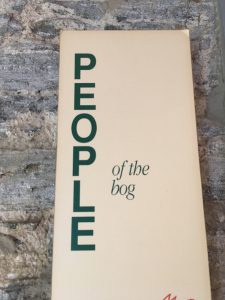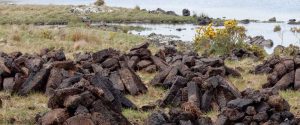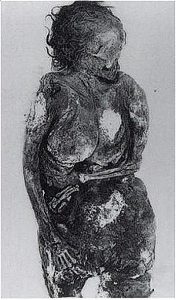I spent my October break in Ireland this year and while I was there, found something that directly relates to our class. My dad and I visited a visitors center near Connemara National Park and found that they were featuring an exhibit on “People of the Bog”. Specifically, the Mennybraddan Woman.
The Mennybraddan Woman is a body that was found by turf cutters in Mennybraddan Bog in 1978. Her body was found relatively well preserved because of the presence of peat in the bog. As the textbook claims, “bod bodies… are undoubtedly the best-known finds from the peat bogs of northwest Europe” (57). The organic material found in these bogs would not have survived outside the waterlogged environment. In the case of the peat bogs, “peat dramatically slows the process of decay” (Dr. R. O. Floinn, National Museum). The bog preserves organic material by sealing it in an airless environment. Places such as lakes, swamps, and bogs play important roles in archaeology because of their ability to effectively maintain organic remains.
A lot of the individuals whose bodies were preserved in the Irish bogs met their deaths through either sacrifice or through violence. The textbook references the Clonycavan Man who “had been killed with axe blows and possibly disemboweled” and the Oldcroghan Man who had been decapitated (58). The Clonycavan Man’s body was actually displayed in a museum in Dublin alongside the Mennybraddan Woman, though the bodies were found in different locations. However, the Mennybraddan Woman’s cause of death is unknown (Dr. R. O. Floinn, National Museum). She has not been suspected of being murdered, though, because her body does not show signs of a violent end.
In an article written about the discovery, she was described as being buried without any other items around her. Her only accompaniment was a woolen blanket that she had been wrapped in. Could this statement about being buried with no items be premature? What if looters took the items? Could the items have decomposed even though her body had been preserved? As archaeologists, we must consider all the possibilities. However, if it is true that if she had been buried without anything, her death may imply sacrifice or suicide. PBS concludes that her death was either a result of either a murder or a suicide. Because her death did not appear violent, I would guess suicide.
The Mennybraddan Woman is a fascinating archaeological discovery. Centuries-old bodies give us a glimpse into what life was like for individuals. Tattoos imprinted on bodies and tools the individuals carried teach us about the persons’ life and the lives of others at the time. The wool blanket found with the Mennybraddan Woman indicates that she had access to sheep to make wool. It tells us that the climate of the time was cold enough to require a blanket. If her death was sacrificial, it could imply something about the religious beliefs of the time. In conclusion, the discovery of mummified bodies in archaeology can supply a lot of information about past societies and ways of thought.
Sources:
Lewis, Susan K. “Bog Bodies of the Iron Age.” PBS. Public Broadcasting Service. Web. 22 Oct. 2017. http://www.pbs.org/wgbh/nova/bog/iron-nf.html
Deem, James M. “Meenybradden Woman.” Mummy Tombs. Web. 22 Oct. 2017. http://www.mummytombs.com/bog/meenybradden.html
Renfrew, Colin and Paul Bahn. Archaeology Essentials. Thames & Hudson. 2007, 2010, and 2015.
Picture Sources:
Deem, James M. “Meenybradden Woman.” Mummy Tombs. Web. 22 Oct. 2017. http://www.mummytombs.com/bog/meenybradden.html
“Bogs of Ireland.” Culture and Heritage Tours Ireland. http://www.cultureheritagetours.ie/?pagid=bogs-of-ireland
“People of the Bog.” A picture I had taken while on my trip. I took it on October 9th, 2017.
Further Readings:
http://nautil.us/issue/27/dark-matter/the-curious-case-of-the-bog-bodies
https://archive.archaeology.org/online/features/bog/





